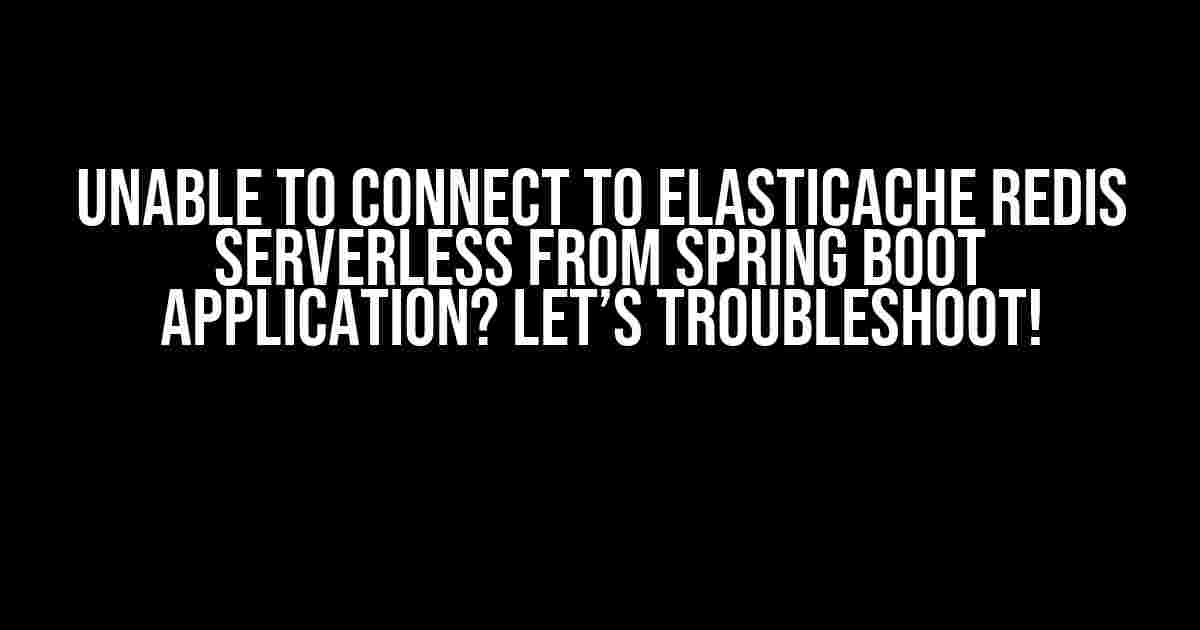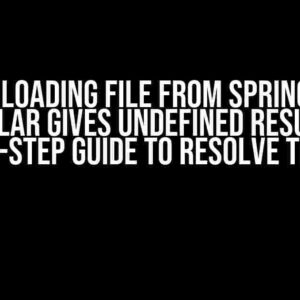Are you struggling to connect to your ElastiCache Redis Serverless instance from your Spring Boot application? You’re not alone! In this article, we’ll dive into the common issues and provide step-by-step solutions to get you up and running in no time. Buckle up, and let’s get started!
Before We Begin
Make sure you have the following prerequisites in place:
- A Spring Boot application set up with Redis dependencies
- An ElastiCache Redis Serverless instance created in AWS
- A basic understanding of Redis and Spring Boot
Step 1: Verify Your Redis Dependencies
In your Spring Boot application, ensure you have the correct Redis dependencies in your pom.xml file (if you’re using Maven) or your build.gradle file (if you’re using Gradle). You can add the following dependencies:
<dependency>
<groupId>org.springframework.boot</groupId>
<artifactId>spring-boot-starter-data-redis</artifactId>
</dependency>
<dependency>
<groupId>redis.clients</groupId>
<artifactId>jedistest</artifactId>
<scope>test</scope>
</dependency>or
dependencies {
implementation 'org.springframework.boot:spring-boot-starter-data-redis'
testImplementation 'redis.clients:jedistest'
}Step 2: Configure Your Redis Connection
In your Spring Boot application, create a configuration file (application.properties or application.yml) with the following properties:
spring:
redis:
host: your-elasticache-redis-instance网址
port: 6379
password: your-redis-password
ssl: true
timeout: 10000Replace your-elasticache-redis-instance网址 with the DNS name or IP address of your ElastiCache Redis Serverless instance. Make sure to include the port number and password as well.
Step 3: Define Your Redis Template
Create a Redis template configuration class to define the connection settings:
@Configuration
public class RedisConfig {
@Value("${spring.redis.host}")
private String host;
@Value("${spring.redis.port}")
private int port;
@Value("${spring.redis.password}")
private String password;
@Bean
public RedisTemplate<String, String> redisTemplate() {
RedisTemplate<String, String> template = new RedisTemplate<>();
template.setConnectionFactory(redisConnectionFactory());
return template;
}
@Bean
public LettuceConnectionFactory redisConnectionFactory() {
LettuceConnectionFactory factory = new LettuceConnectionFactory(host, port);
factory.setPassword(password);
factory.setUseSsl(true);
factory.setTimeout(Duration.ofMillis(10000));
return factory;
}
}Step 4: Test Your Redis Connection
Create a test class to verify your Redis connection:
@RunWith(SpringRunner.class)
@SpringBootTest
public class RedisTest {
@Autowired
private RedisTemplate<String, String> redisTemplate;
@Test
public void testRedisConnection() {
String key = "test-key";
String value = "Hello, Redis!";
redisTemplate.opsForValue().set(key, value);
String getValue = redisTemplate.opsForValue().get(key);
Assert.assertEquals(value, getValue);
}
}Run the test to verify that your Redis connection is working correctly.
Troubleshooting Common Issues
Here are some common issues you might encounter when connecting to your ElastiCache Redis Serverless instance from your Spring Boot application:
| Issue | Solution |
|---|---|
| Unable to connect to Redis instance | Check your Redis instance’s security group settings to ensure inbound traffic is allowed on port 6379. Also, verify your Redis password and host name. |
| Redis timeout errors | Increase the Redis timeout value in your application.properties file or adjust the timeout settings in your Redis instance. |
| SSL/TLS connection issues | Ensure SSL/TLS is enabled on your Redis instance and your Spring Boot application is configured to use SSL/TLS. |
| Missing dependencies | Verify that you have the correct Redis dependencies in your pom.xml or build.gradle file. |
Conclusion
That’s it! By following these steps and troubleshooting common issues, you should be able to successfully connect to your ElastiCache Redis Serverless instance from your Spring Boot application. Remember to double-check your Redis dependencies, configuration, and security settings to ensure a smooth connection. Happy coding!
Additional Resources
For further reading and reference:
Here are the 5 Questions and Answers about “Unable to connect to ElastiCache Redis Serverless from Spring Boot Application” in HTML format:
Frequently Asked Question
Stuck with connecting to ElastiCache Redis Serverless from your Spring Boot application? We’ve got you covered! Here are some frequently asked questions to help you troubleshoot the issue:
Q1: Why am I getting a “Connection refused” error when trying to connect to ElastiCache Redis Serverless from my Spring Boot application?
A1: This error usually occurs when the ElastiCache Redis Serverless cluster is not properly configured or the Spring Boot application is not pointing to the correct endpoint. Make sure to check the cluster’s configuration, especially the security group settings and the endpoint URL. Also, ensure that the Redis client in your Spring Boot application is using the correct connection details.
Q2: How do I ensure that my Spring Boot application is using the correct connection details to connect to ElastiCache Redis Serverless?
A2: To ensure that your Spring Boot application is using the correct connection details, you need to configure the Redis client with the correct endpoint URL, port, and password. You can do this by adding the relevant configuration properties to your application.properties or application.yml file. For example, you can add the following properties: `spring.redis.host=
Q3: What are the common security group settings that I need to configure to allow my Spring Boot application to connect to ElastiCache Redis Serverless?
A3: To allow your Spring Boot application to connect to ElastiCache Redis Serverless, you need to configure the security group settings to allow inbound traffic on the Redis port (default is 6379). You also need to ensure that the security group associated with your ElastiCache Redis Serverless cluster allows outbound traffic to the Spring Boot application.
Q4: Can I use ElastiCache Redis Serverless with a VPC-enabled Spring Boot application?
A4: Yes, you can use ElastiCache Redis Serverless with a VPC-enabled Spring Boot application. Just ensure that the ElastiCache Redis Serverless cluster is created in the same VPC as your Spring Boot application, and the security group settings are configured to allow communication between the two.
Q5: What are some additional troubleshooting steps I can take to resolve the connection issue with ElastiCache Redis Serverless?
A5: If you’ve checked all the configuration settings and security group settings, but still can’t connect to ElastiCache Redis Serverless, try checking the Redis server logs for any errors, verify that the ElastiCache Redis Serverless cluster is in the available state, and ensure that the Spring Boot application is using the correct Redis client library and version.
I hope this helps you troubleshoot the connection issue with ElastiCache Redis Serverless from your Spring Boot application!


